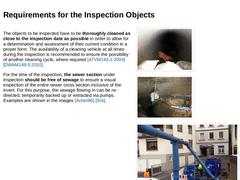
|
The objects to be inspected have to be thoroughly cleaned as close to the inspection date as possible in order to allow for a determination and assessment of their current condition in a proper form. The availability of a cleaning vehicle at all times during the inspection is recommended to ensure the possibility of another cleaning cycle, where required [ATVM143-1:2004] [DWAM149-5:2010]. For the time of the inspection, the sewer section under inspection |
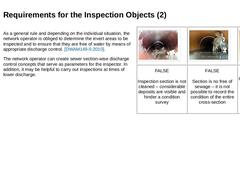
|
As a general rule and depending on the individual situation, the network operator is obliged to determine the invert areas to be inspected and to ensure that they are free of water by means of appropriate discharge control. [DWAM149-5:2010]. The network operator can create sewer section-wise discharge control concepts that serve as parameters for the inspector. In addition, it may be helpful to carry out inspections at times of lower discharge. |
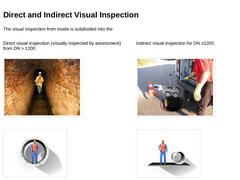
|
The visual inspection from inside is subdivided into the: Direct visual inspection (visually inspected by assessment) from DN > 1200 (Image: Accessible brick sewer) (Image: Picto Manned techniques / accessible) Indirect visual inspection for DN ≤1200
(Image: Not accessible pipe cross-section) (Image: PICTO Not accessible / unmanned) |
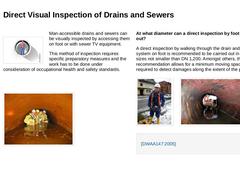
|
(Image: Begehbar) Man-accessible drains and sewers can be visually inspected by accessing them on foot or with sewer TV equipment. This method of inspection requires specific preparatory measures and the work has to be done under consideration of occupational health and safety standards. (Image: Direct inspection of a culvert) At what diameter can a direct inspection by foot be carried out? A direct inspection by walking through the drain and sewer system … |
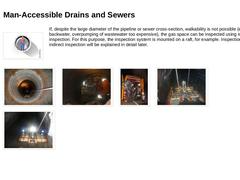
|
(Image: Begehbar) If, despite the large diameter of the pipeline or sewer cross-section, walkability is not possible (e.g. diversion, backwater, overpumping of wastewater too expensive), the gas space can be inspected using indirect inspection. For this purpose, the inspection system is mounted on a raft, for example. Inspection systems for indirect inspection will be explained in detail later. (Image: Indirect inspection of a large profile pipe with … |
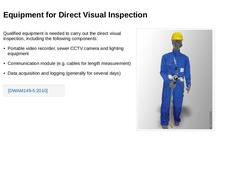
|
Qualified equipment is needed to carry out the direct visual inspection, including the following components: -
Portable video recorder, sewer CCTV camera and lighting equipment
-
Communication module (e.g. cables for length measurement)
-
Data acquisition and logging (generally for several days)
(Image: Portable sewer inspection system for walk-in sewage systems) |
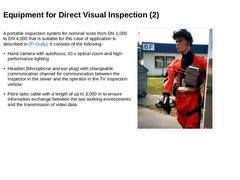
|
A portable inspection system for nominal sizes from DN 1,000 to DN 4,000 that is suitable for this case of application is described in [FI-Gully]. It consists of the following: -
Hand camera with autofocus, 10 x optical zoom and high-performance lighting
-
Headset (Microphone and ear plug) with changeable communication channel for communication between the inspector in the sewer and the operator in the TV inspection vehicle
-
Fibre optic cable with a …
|
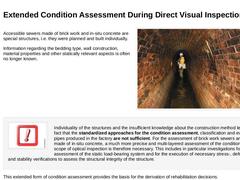
|
Accessible sewers made of brick work and in-situ concrete are special structures, i.e. they were planned and built individually. Information regarding the bedding type, wall construction, material properties and other statically relevant aspects is often no longer known. (Image: Condition evaluation by inspection in a brick work sewer - Neu) Important: Individuality of the structures and the insufficient knowledge about the construction method lead … |
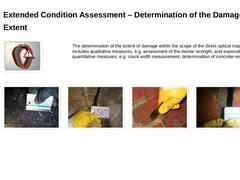
|
The determination of the extent of damage within the scope of the direct optical inspection includes qualitative measures, e.g. assessment of the mortar strength, and especially quantitative measures, e.g. crack width measurement, determination of concrete removal, etc. (Image: Recording the extent of damage - Crack width measurement) (Image: Recording the extent of damage - Crack width measurement - Bild 2) (Image: Recording … |
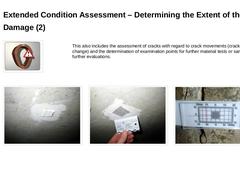
|
This also includes the assessment of cracks with regard to crack movements (crack width change) and the determination of examination points for further material tests or sampling for further evaluations. (Image: Placing a plaster mark over a crack) (Image: Removing a plaster mark over a crack) (Image: Crack mark gauge to determine the crack width development) |
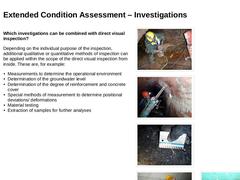
|
Which investigations can be combined with direct visual inspection? Depending on the individual purpose of the inspection, additional qualitative or quantitative methods of inspection can be applied within the scope of the direct visual inspection from inside. These are, for example: -
Measurements to determine the operational environment
-
Determination of the groundwater level
-
Determination of the degree of reinforcement and concrete cover
-
Special …
|
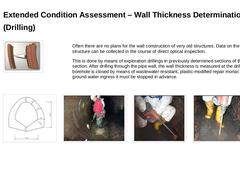
|
(Image: Icon Mauerwerk Wanddicke) Often there are no plans for the wall construction of very old structures. Data on the wall structure can be collected in the course of direct optical inspection. This is done by means of exploration drillings in previously determined sections of the cross section. After drilling through the pipe wall, the wall thickness is measured at the drill. The borehole is closed by means of wastewater resistant, plastic-modified … |
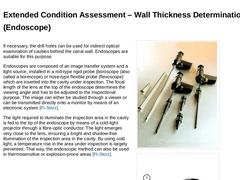
|
If necessary, the drill holes can be used for indirect optical examination of cavities behind the canal wall. Endoscopes are suitable for this purpose. Endoscopes are composed of an image transfer system and a light source, installed in a rod-type rigid probe (boroscope (also called a borescope) or hose-type flexible probe (flexoscope) which are inserted into the cavity under inspection. The focal length of the lens at the top of the endoscope determines … |
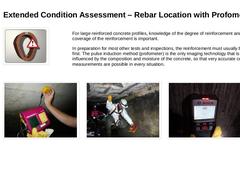
|
For large reinforced concrete profiles, knowledge of the degree of reinforcement and the coverage of the reinforcement is important. In preparation for most other tests and inspections, the reinforcement must usually be located first. The pulse induction method (profometer) is the only imaging technology that is not influenced by the composition and moisture of the concrete, so that very accurate concrete cover measurements … |
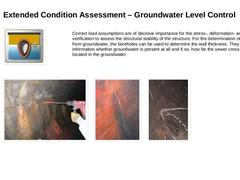
|
(Image: Icon Mauerwerk Grundwasser) Correct load assumptions are of decisive importance for the stress-, deformation- and stability verification to assess the structural stability of the structure. For the determination of the load from groundwater, the boreholes can be used to determine the wall thickness. They provide information whether groundwater is present at all and if so, how far the sewer cross-section is located in the groundwater. (Image: … |
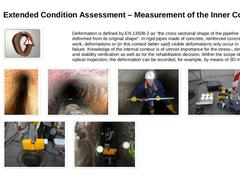
|
Deformation is defined by EN 13508-2 as “the cross sectional shape of the pipeline has been deformed from its original shape". In rigid pipes made of concrete, reinforced concrete or brick work, deformations or (in this context better said) visible deformations only occur in case of static failure. Knowledge of the internal contour is of utmost importance for the stress-, deformation and stability verification as well as for … |
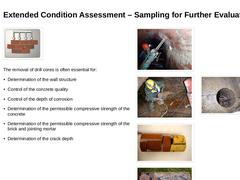
|
(Image: Icon Mauerwerk Last) The removal of drill cores is often essential for: -
Determination of the wall structure
-
Control of the concrete quality
-
Control of the depth of corrosion
-
Determination of the permissible compressive strength of the concrete
-
Determination of the permissible compressive strength of the brick and jointing mortar
-
Determination of the crack depth
(Image: Drill core sampling/extraction with drill core equipment in a walk-… |
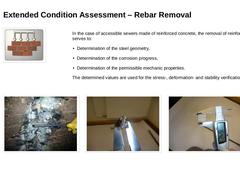
|
(Image: Icon Mauerwerk Last) In the case of accessible sewers made of reinforced concrete, the removal of reinforcing steel serves to: -
Determination of the steel geometry,
-
Determination of the corrosion progress,
-
Determination of the permissible mechanic properties.
The determined values are used for the stress-, deformation- and stability verification. (Image: Removal of reinforcing steel in a large profile) (Image: Removal of reinforcing steel … |
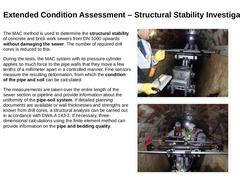
|
The MAC method is used to determine the structural stability of concrete and brick work sewers from DN 1000 upwards without damaging the sewer. The number of required drill cores is reduced to this. During the tests, the MAC system with its pressure cylinder applies so much force to the pipe walls that they move a few tenths of a millimeter apart in a controlled manner. Fine sensors measure the resulting deformation, from which the condition of the … |
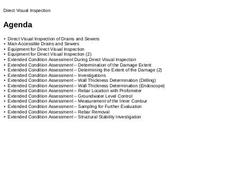
|
|
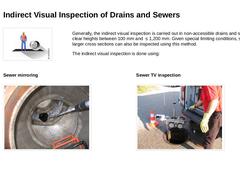
|
Generally, the indirect visual inspection is carried out in non-accessible drains and sewers with clear heights between 100 mm and ≤ 1,200 mm. Given special limiting conditions, smaller or larger cross sections can also be inspected using this method. The indirect visual inspection is done using: Sewer mirroring (Image: Indirect optical inspection of a sewerage system by means of a sewer mirror) Sewer TV inspection (Image: Indirect … |
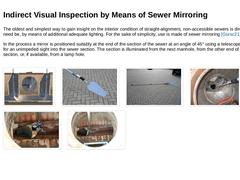
|
The oldest and simplest way to gain insight on the interior condition of straight-alignment, non-accessible sewers is direct viewing – if need be, by means of additional adequate lighting. For the sake of simplicity, use is made of sewer mirroring [Gürsc21]. In the process a mirror is positioned suitably at the end of the section of the sewer at an angle of 45° using a telescope bar to allow for an unimpeded sight into the sewer section. The section … |
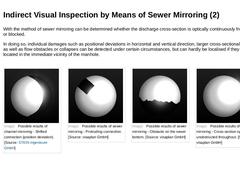
|
With the method of sewer mirroring can be determined whether the discharge cross-section is optically continuously free, restricted or blocked. In doing so, individual damages such as positional deviations in horizontal and vertical direction, larger cross-sectional deformations as well as flow obstacles or collapses can be detected under certain circumstances, but can hardly be localised if they are not located in the immediate vicinity of the manhole. |
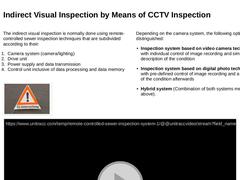
|
The indirect visual inspection is normally done using remote-controlled sewer inspection techniques that are subdivided according to their: -
Camera system (camera/lighting)
-
Drive unit
-
Power supply and data transmission
-
Control unit inclusive of data processing and data memory
(Image: Achtung TV-Untersuchung) Depending on the camera system, the following options are distinguished: |
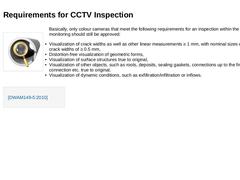
|
(Image: Picto Inspektion) Basically, only colour cameras that meet the following requirements for an inspection within the scope of self-monitoring should still be approved: -
Visualization of crack widths as well as other linear measurements ≥ 1 mm, with nominal sizes of ≤ DN 300 crack widths of ≥ 0.5 mm,
-
Distortion-free visualization of geometric forms,
-
Visualization of surface structures true to original,
-
Visualization of other objects, such as …
|